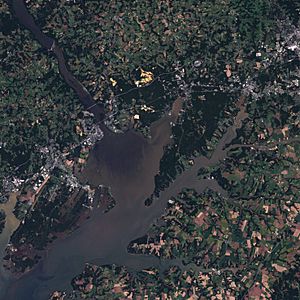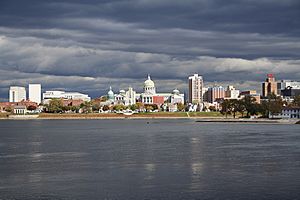Susquehanna River facts for kids
Quick facts for kids Susquehanna River |
|
|---|---|
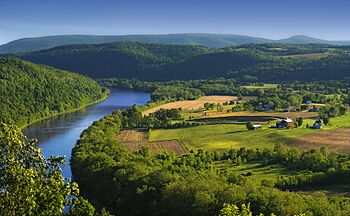
Susquehanna River in Bradford County, Pennsylvania
|
|

Map of the Susquehanna River watershed
|
|
| Country | United States |
| States | New York, Pennsylvania, Maryland |
| Cities | (in order starting north and ending south) Binghamton, NY, Pittston, PA, Wilkes-Barre, PA, Williamsport, PA, Bloomsburg, PA, Northumberland, PA, Sunbury, PA, Harrisburg, PA (PA state capital), Port Deposit, MD, Havre de Grace, MD |
| Physical characteristics | |
| Main source | Otsego Lake Cooperstown, Otsego County, New York, USA 1,191 ft (363 m) 42°42′02″N 74°55′10″W / 42.70056°N 74.91944°W |
| River mouth | Chesapeake Bay Havre de Grace, Cecil County / Harford County, Maryland, USA 0 ft (0 m) 39°32′35″N 76°04′32″W / 39.54306°N 76.07556°W |
| Length | 444 mi (715 km) |
| Discharge (location 2) |
|
| Basin features | |
| Basin size | 27,500 sq mi (71,000 km2) |
| Tributaries | |
The Susquehanna River (pronounced SUSS-kwə-HAN-ə) is a very important river in the eastern United States. It flows through three states: New York, Pennsylvania, and Maryland. At 444 miles (715 km) (715 km) long, it is the longest river on the East Coast of the United States.
The Susquehanna River gets its water from a huge area of 27,500 square miles (71,000 km2) (71,000 km²). This includes almost half of Pennsylvania's land. The river ends by flowing into the northern part of the Chesapeake Bay. It provides half of the fresh water that flows into the Bay.
The river has two main parts, called branches. The North Branch starts in Cooperstown, New York. The West Branch starts in western Pennsylvania. These two branches join together in central Pennsylvania near Northumberland.
Contents
How the Susquehanna River Formed
The Susquehanna River is one of the oldest rivers in the world. Scientists believe it is about 320 to 340 million years old. This means it is even older than the mountains it flows through!
These mountains, called the Appalachian Mountains, were formed when continents crashed into each other. The river was already flowing across the land before these mountains pushed up. This is why the river cuts through the mountains in a zigzag path.
The River's Journey
The Susquehanna River has always been important for travel and trade. Before trains became popular, people used ferries and boats on the river. They moved goods like coal using canals built along the river. Even today, train tracks run along the river's banks.

North Branch: The Main Start
The longer part of the river, the North Branch, begins at Otsego Lake in Cooperstown, New York. From there, it flows through farms and dairy lands. It then dips into Pennsylvania, making sharp turns.
It flows back into New York and meets the Chenango River in Binghamton. After more turns, it crosses back into Pennsylvania. It passes towns like Wilkes-Barre and Bloomsburg. Finally, it joins the West Branch at Northumberland.
West Branch: From Western Pennsylvania
The West Branch starts near Elmora, Pennsylvania. It flows northeast through towns like Clearfield. In Clearfield, the river is dammed to create a lake.
The West Branch then turns southeast. It passes through Lock Haven and Williamsport. Many smaller streams join it along the way. The largest stream joining the West Branch is Pine Creek. The West Branch then turns south before meeting the North Branch at Northumberland.
The Main Susquehanna Flow
After the two branches meet in Northumberland, the river flows south. It passes Selinsgrove and then the city of Harrisburg. Harrisburg is the capital of Pennsylvania and the largest city on the lower river.
The river then forms the border between York and Lancaster counties. It crosses into northern Maryland about 30 miles (48 km) (48 km) northeast of Baltimore. The Susquehanna River finally flows into the northern end of the Chesapeake Bay at Havre de Grace.
What Does "Susquehanna" Mean?
The name "Susquehanna" comes from Native American languages. One idea is that it comes from the Lenape word siskëwahane, which means "Muddy River."
Another idea is that it comes from the Lenape term Sisa'we'hak'hanna, meaning "Oyster River." There used to be many oyster beds near the river's mouth. The Lenape people collected these oysters.
A third idea is that the name comes from the Susquehannock language. This language was spoken by a different Native American group. In their language, it might mean "the stream that falls toward the south" or "long-crooked-river."
A Look at the River's History
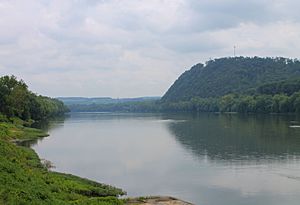
In 1615, a French explorer named Étienne Brûlé traveled on the river. Later, in the 1670s, a powerful Native American group called the Iroquois took control of the area. They wanted to control the fur trade with Europeans.
The Susquehanna River was very important during the early days of the United States. In the 1700s, William Penn, who founded Pennsylvania, made agreements with the Lenape people. This allowed settlers to move into the area. The river also became a key way to transport coal from the mountains to markets.
During the American Revolutionary War in 1779, General James Clinton used the river for a military expedition. His group made the upper river easier to travel by building a temporary dam at Otsego Lake. They then broke the dam, creating a flood that helped their boats travel downstream.
Later, in 1790, a survey was done to see if the Susquehanna could be connected to the Allegheny River. This would create a water route to Pittsburgh and the Ohio River. In 1792, the Union Canal was planned to link the Susquehanna and Delaware rivers.
In the 1800s, many factories and towns grew along the Susquehanna. They used the river's water power and for shipping goods. However, when railroads became popular, river travel became less common because trains were faster.
The Susquehanna River is also important in the history of the Latter Day Saint movement. Members believe that Joseph Smith and Oliver Cowdery received special powers and performed their first baptisms in the North Branch of the river in 1829.
During the American Civil War in 1863, Union Army leaders made sure the Confederate Army could not cross the Susquehanna. They protected important bridges and river crossings.
The river has also seen major floods. In 1972, Hurricane Agnes caused terrible flooding, especially in Wilkes-Barre, Pennsylvania, and Harrisburg. The huge amount of fresh water also harmed the Chesapeake Bay ecosystem. More floods happened in 2006 and 2011 from other storms.
Bridges, Ferries, and Dams
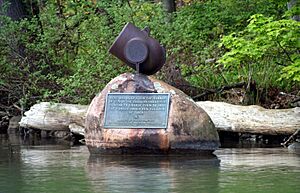
For a long time, the Susquehanna River was a barrier between northern and southern states. People could only cross it by ferry. The river also had many fast-moving parts called rapids. This meant boats could only travel downstream when the water was high.
To make the river more useful for shipping, canals were built in the 1820s and 1830s. These canals helped barges move goods. But by the 1850s, railroads became much faster and cheaper. Many railroads were even built on top of the old canal paths. You can still see parts of these old canals today.
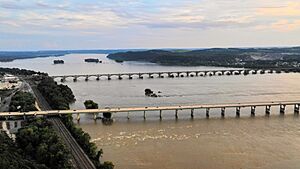
Today, over 200 bridges cross the Susquehanna. The Rockville Bridge near Harrisburg is the longest stone arch bridge in the world. It was built in 1902 for trains.
Two ferries still operate on the river. The Millersburg Ferry carries cars and people. The Pride of the Susquehanna in Harrisburg offers fun boat rides for passengers. Most old canals are now parks or filled in. Dams on the river are mainly used to create electricity or lakes for fun activities.

Environmental Concerns
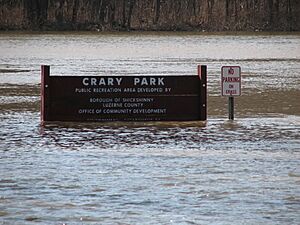
The Susquehanna River faces environmental challenges. In 2005, it was called "America's Most Endangered River" by an environmental group. This is because of too much pollution.
Most of the pollution comes from farm animal waste, water running off farms and cities, and untreated sewage. The river sends a lot of pollution into the Chesapeake Bay. This pollution can harm the Bay's plants and animals.
The river is also monitored for radioactivity. This is because of the 1979 Three Mile Island accident at a nuclear power plant on the river. However, many studies over 25 years have shown that the accident did not cause harmful radiation effects in the river. The nuclear reactor at Three Mile Island was shut down in 2019.
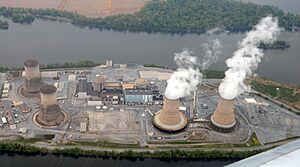
In 2015, a fish called a smallmouth bass was found with a rare tumor. This raised new worries about pollution in the river. The Environmental Protection Agency (EPA) is still studying the river's health.
Fun on the Susquehanna River
The Susquehanna River is a great place for outdoor activities. Many people enjoy boating, kayaking, and canoeing. Fishing is also very popular, especially for smallmouth bass. The river hosts many bass fishing tournaments each year.
Canoe races are held every year on different parts of the river. For example, the General Clinton Canoe Regatta is a long race that takes place in Bainbridge, New York, every Memorial Day weekend.
The Appalachian Trail, a famous hiking path, crosses the Susquehanna River at the Clarks Ferry Bridge near Duncannon, Pennsylvania.
See also
 In Spanish: Río Susquehanna para niños
In Spanish: Río Susquehanna para niños
- List of crossings of the Susquehanna River
- City Island (Pennsylvania)
- Garrett Island (Maryland)
- Geography of Pennsylvania
- List of Maryland rivers
- List of New York rivers
- List of Pennsylvania rivers
- McCormick Island
- Spades Wharf Island
- Three Mile Island accident


